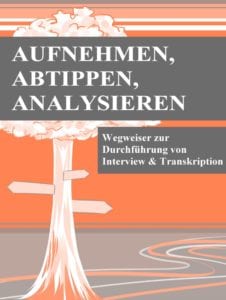Audiotranskription – was ist das?

Bei der Audiotranskription wird eine Audiospur zu Text umgewandelt. Als Ergebnis erhält man ein Audiotranskript. Solche Audiotranskripte können vielfältig weiterverwendet werden. Sie dienen dabei zum einen als Gedächtnisstütze und bilden zum anderen die Arbeitsgrundlage für eine Analyse und Weiterverarbeitung der gewonnenen Daten.
Das Gesprochene ist leichter zugänglich und kann u.a. für Abschlussarbeiten, zu Marktforschungszwecken, zum Abdrucken in den Medien und für vieles weitere genutzt werden. Besonders häufig werden Audios im Rahmen von Interviews transkribiert.
 You can also find many more useful tips in our eBook Recording, typing, analyzing - a guide to conducting interviews and transcriptions.
You can also find many more useful tips in our eBook Recording, typing, analyzing - a guide to conducting interviews and transcriptions.
The book is available as a free download: Now everything about transcription & Co!
Welche Regeln gibt es für die Audiotranskription?
Je nachdem wofür die Audiotranskription benötigt wird, können unterschiedliche Transkriptionsregeln angewandt werden. Meist genügt jedoch die Audiotranskription nach einfachen Regeln. Dabei wird das Gesprochene wortgenau wiedergegeben. Die Sprache wird nach einfachen Regeln leicht geglättet, was bedeutet, dass Stotterer, Wortabbrüche und Zwischenlaute („ähs“ und „ähms“) zugunsten der Lesbarkeit nicht erfasst werden.
Bei einer Audiotranskription nach erweiterten Regeln wird die Sprache hingegen nicht geglättet. Diese Regeln werden vor allem dann angewandt, wenn die sprachlichen Besonderheiten Teil der anschließenden Analyse sind.
Generell können bei der Audio Transkription viele weitere Aspekte berücksichtigt werden. Zum Beispiel kann das Audiotranskript stark geglättet werden, um einen druckreifen Text zu erzeugen. Hilfreich ist oftmals auch das Einfügen von Zeilennummern und Zeitstempeln (im Format #hh:mm:ss#, wobei h für Stunde, m für Minute und s für Sekunde steht), die regulär nach einem Sprecherwechsel gesetzt werden. Sowohl Zeilennummern als auch Zeitstempel erleichtern u.a. das Wiederfinden von Textpassagen.
Insbesondere im Bereich der Sprachwissenschaften gibt es zudem viele komplexe Regeln, zum Beispiel Regeln zur Berücksichtigung der Intonation, der Sprechgeschwindigkeit oder nonverbale Handlungen wie Gestik oder Mimik.
Bei abtipper.de erfolgt die Audiotranskription nach eigenen wissenschaftlich zitierfähigen Transkriptionsregeln in einfacher und erweiterter Form. Für Abschlussarbeiten und wissenschaftliche Studien bietet sich die Audiotranskription nach dem 4-Augen Prinzip an.
Bei der wissenschaftlichen Audiotranskription wird das Audiotranskript noch einmal zusätzlich von einem Lektor geprüft. Darüber hinaus bieten wir auf Anfrage auch die Audiotranskription nach komplexen Regeln wie TIQ, GAT2 und weitere an. Das Resultat ist dann ein Transkript, in selteneren Fällen wird dies auch Audiotranskript genannt.
Wie gelingt eine schnelle Audiotranskription?
Der Vorgang der manuellen Audiotranskription ist aufwendig und zeitintensiv. Je nach Tippgeschwindigkeit und anzuwendenden Transkriptionsregeln wird dafür die 3- bis 10-fache Zeit der zu transkribierenden Audiominuten benötigt.
Um den Arbeitsaufwand zu minimieren, kann eine Transkriptionssoftware bei der Audiotranskription helfen.
Transkriptionssoftware enthält viele nützliche Funktionen, beispielsweise kann die Wiedergabegeschwindigkeit variiert werden, Tastenkombinationen festgelegt werden, um mauslos transkribieren zu können oder die Transkriptionssoftware kann mit einem Fußschalter gekoppelt werden, mit denen z.B. innerhalb der Aufnahme vor- und zurückgespult werden kann. Transkriptionssoftware gibt es wahlweise auch im Transkriptionsset mit einem Diktiergerät, Kopfhörern und Fußschalter. Im Set ist Transkriptionssoftware meist kostenintensiv, ansonsten ist die Software auch kostenlos erhältlich (z.B. die Express Scribe Transkriptionssoftware von NCH Software). Andere Programme wie f4transkript sind nicht gratis, es gibt aber eine kostenlose Testversion. Falls ein Fußschalter benötigt wird, muss dieser dann separat angeschafft werden.
Eine weitere Möglichkeit der schnellen Audiotranskription ist die Beauftragung eines Dienstleisters. Neben unserem regulären Service, bei dem das Audiotranskript in ca. einer Woche geliefert wird, bieten wir zusätzlich zwei Express-Optionen, den 1-Tages-Express und den 3 Tages-Express, an. Weitere Informationen dazu finden Sie hier:
Beauftragen Sie jetzt Ihre Audiotranskription!
Further questions and answers
Eine Audiotranskription ist die Umwandlung von einer Audiospur in Text. Dies erfolgt meist anhand spezifischer Transkriptionsregeln. Das Resultat dieser Tätigkeit ist ein Audiotranskript, was meist vereinfacht als Transkript bezeichnet wird.
Die Erstellung einer Audiotranskription kann manuell durch Transkribieren oder maschinell durch eine automatische Spracherkennung erfolgen.
Die Spracherkennung ist dabei nach heutigem Stand vor allem dann geeignet, wenn eine mittlere Qualität ausreicht. Wenn eine hohe Qualität erforderlich ist, dann ist eine manuelle Audiotranskription die zu wählende Alternative.
Bei der Erstellung einer Audiotranskription kann eine Transkriptionssoftware helfen. Es gibt einige kostenlose Programme. Durch den viel größeren Funktionsumfang und Komfort sind die kostenpflichtigen Tools wie ExpressScribe oder f4transkript bei größeren Mengen empfehlenswert.
Für eine vollständig automatisierte Audiostranskription ist eine Spracherkennung möglich.
